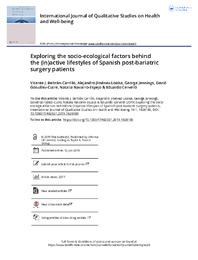Please use this identifier to cite or link to this item:
https://hdl.handle.net/11000/32932Full metadata record
| DC Field | Value | Language |
|---|---|---|
| dc.contributor.author | Beltrán-Carrillo, Vicente J. | - |
| dc.contributor.author | Jiménez-Loaisa, Alejandro | - |
| dc.contributor.author | JENNINGS, GEORGE | - |
| dc.contributor.author | González-Cutre, David | - |
| dc.contributor.author | Navarro-Espejo, Natalia | - |
| dc.contributor.author | Cervelló, Eduardo | - |
| dc.contributor.other | Departamentos de la UMH::Ciencias del Deporte | es_ES |
| dc.date.accessioned | 2024-09-04T12:19:34Z | - |
| dc.date.available | 2024-09-04T12:19:34Z | - |
| dc.date.created | 2019-06-12 | - |
| dc.identifier.citation | INTERNATIONAL JOURNAL OF QUALITATIVE STUDIES ON HEALTH AND WELL-BEING 2019, VOL. 14 | es_ES |
| dc.identifier.issn | 1748-2631 | - |
| dc.identifier.issn | 1748-2623 | - |
| dc.identifier.uri | https://hdl.handle.net/11000/32932 | - |
| dc.description.abstract | Purpose: Physical activity (PA) is considered essential for the treatment of morbid obesity and the optimization of bariatric surgery outcomes. The objective of this article was to identify the facilitators and barriers that bariatric patients perceived to do PA one year after finishing a PA programme for the promotion of a long-term active lifestyle. This objective was addressed from a socio-ecological and qualitative perspective. Methods: Nine patients (eight women and one man), aged between 31 and 59 years, participated in semi-structured interviews directly following the PA programme and one year after it. A content analysis was carried out to analyze the qualitative data. Results: Weight loss, improvement of physical fitness, perceived competence, and enjoyment were the main facilitators of PA. Complexes related to skin folds, osteoarthritis, perceived unfavourable weather conditions, lack of social support and economic resources, long workdays, lack of specific PA programmes, and other passive leisure preferences were the main barriers to participate in PA. Conclusions: Results highlight the important interplay between personal, social environmental, and physical environmental factors to explain (in)active behaviours of bariatric patients. The findings of this article could be useful for future research and interventions aimed at promoting PA in bariatric patients. | es_ES |
| dc.format | application/pdf | es_ES |
| dc.format.extent | 11 | es_ES |
| dc.language.iso | eng | es_ES |
| dc.publisher | Taylor and Francis Group | es_ES |
| dc.rights | info:eu-repo/semantics/openAccess | es_ES |
| dc.rights | Attribution-NonCommercial-NoDerivatives 4.0 Internacional | * |
| dc.rights.uri | http://creativecommons.org/licenses/by-nc-nd/4.0/ | * |
| dc.subject | Physical activity | es_ES |
| dc.subject | exercise | es_ES |
| dc.subject | obesity | es_ES |
| dc.subject | environment | es_ES |
| dc.subject | barriers | es_ES |
| dc.subject | facilitators | es_ES |
| dc.subject.other | CDU::7 - Bellas artes::79 - Diversiones. Espectáculos. Cine. Teatro. Danza. Juegos.Deportes | es_ES |
| dc.title | Exploring the socio-ecological factors behind the (in)active lifestyles of Spanish post-bariatric surgery patients | es_ES |
| dc.type | info:eu-repo/semantics/article | es_ES |
| dc.relation.publisherversion | https://doi.org/10.1080/17482631.2019.1626180 | es_ES |

View/Open:
3 RediUMH VJBC.pdf
1,67 MB
Adobe PDF
Share:
.png)
